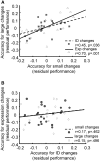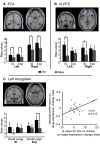Distinct frontal and amygdala correlates of change detection for facial identity and expression
- PMID: 26245835
- PMCID: PMC4733333
- DOI: 10.1093/scan/nsv104
Distinct frontal and amygdala correlates of change detection for facial identity and expression
Abstract
Recruitment of 'top-down' frontal attentional mechanisms is held to support detection of changes in task-relevant stimuli. Fluctuations in intrinsic frontal activity have been shown to impact task performance more generally. Meanwhile, the amygdala has been implicated in 'bottom-up' attentional capture by threat. Here, 22 adult human participants took part in a functional magnetic resonance change detection study aimed at investigating the correlates of successful (vs failed) detection of changes in facial identity vs expression. For identity changes, we expected prefrontal recruitment to differentiate 'hit' from 'miss' trials, in line with previous reports. Meanwhile, we postulated that a different mechanism would support detection of emotionally salient changes. Specifically, elevated amygdala activation was predicted to be associated with successful detection of threat-related changes in expression, over-riding the influence of fluctuations in top-down attention. Our findings revealed that fusiform activity tracked change detection across conditions. Ventrolateral prefrontal cortical activity was uniquely linked to detection of changes in identity not expression, and amygdala activity to detection of changes from neutral to fearful expressions. These results are consistent with distinct mechanisms supporting detection of changes in face identity vs expression, the former potentially reflecting top-down attention, the latter bottom-up attentional capture by stimulus emotional salience.
Keywords: amygdala; change detection; expression; faces; identity; prefrontal.
© The Author (2015). Published by Oxford University Press.
Figures



References
-
- Ashburner J., Friston K.J. (2005). Unified segmentation. Neuroimage, 26, 839–51. - PubMed
-
- Beck D.M., Rees G., Frith C.D., Lavie N. (2001). Neural correlates of change detection and change blindness. Nature Neuroscience, 4, 645–50. - PubMed
-
- Bishop S., Duncan J., Brett M., Lawrence A.D. (2004a). Prefrontal cortical function and anxiety: controlling attention to threat-related stimuli. Nature Neuroscience, 7, 184–8. - PubMed
Publication types
MeSH terms
Grants and funding
LinkOut - more resources
Full Text Sources
Other Literature Sources

